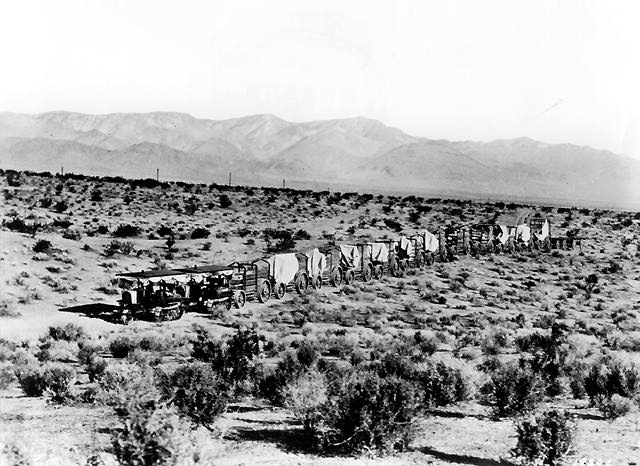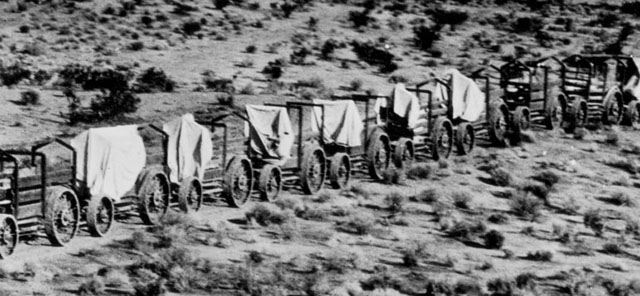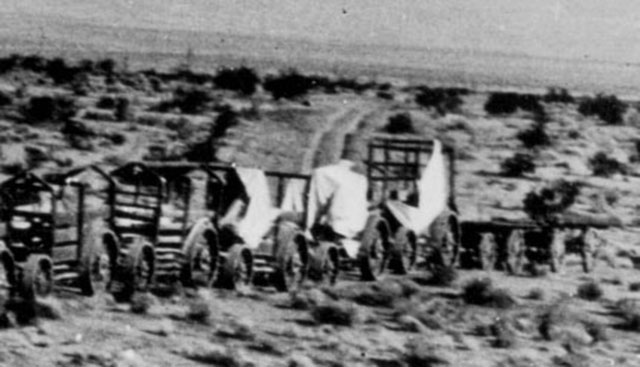








Steam Tractors Pulling Supply Wagon Train in Mojave Desert
Photo from the Cowley County Historical Museum, Winfield, KS

From Note on Photo:
One of the early markets for the track type tractor was overland hauling. Here two catapiller 45 tractors form a double header to pull a wagon train across the Mojave desert during the construction of the Los Angeles Aqueduct in 1909.
Details

Tractor at head of train

Wagons in Mid train

Wagons at tail end of train
Subject: Re: Steam tractor photo
Date: Thu, 10 Apr 2003
From: Alan Radecki
To: "William W. Bottorff"
Hi Bill,
Here's the skinny on the wagons:
The typical freighter wagons could carry between 14,000 and 20,000 pounds each, and themselves weighed between 7,000 and 8,000 pounds each. The largest, costing $900 each (an enormous sum for that time) were designed by J. W. S. Perry and were built in Mojave (a California historical marker indicates the site).
The rear wheels were typically 7 feet in diameter and had an iron tire eight inches wide and an inch thick. The forward wheel was five ft in diameter with a tire similar to the rear's. The hubs were 18 inches in diameter, 22 inches long. Spokes were of split oak, 5 1/2 inches wide at the butt, four inches wise at the point. The felloes [the curved wood sections forming the wheel rim) were made double, each piece 4 x 4 ichnes in cross section, the two being edge bolted together. The forward axle trees were solid steel bars, 3.25 inhces square, and the rear were 3.5 inches square. Wagon beds were 14 to 16 feet long, four wide, and depending on the load, anywhere from 4 to 10 feet deep.
The first wagon had a standard tongue in front and a 3 foot wrought iron tongue in back. The second wagon (and subsequent likewise) had a 6 foot tongue with a stout vertical ring on the end which, when the two wagons were coupled, slid over the 3 ft tail tongue of the first wagon. To hold the wagons together, a stout chain was run from the front axle of one to the front axle of the other.
The heavy duty freighting wagons were developed by the mining industry and were typically pulled by 18 - 22 mules, which later of course were replaced by the steam cats. They had to be as stout as they were so that they could haul in the heavy mining equipment and haul out the ore and the bullion (to foil the outlaws, the gold or silver would usually be cast into 500 lb or heavier bars so that they couldn't easily or speedily be spirited off).
The building of the aquaduct seems to have occurred during an intersting transition period. Photos still show large mule teams being used on some parts of the project, while other photos show the steam tractors. I am guessing (and it's only a guess, as I haven't yet been able to positively document this) that one of the reasons for this was that the steam cat naturally needed fuel oil and water to run, and in the two photos I've seen, neither show any tank wagons being pulled with the rest of the train; so I'm guessing they weren't used over too long of a distance. This also was one of the last uses of the large freighting wagons, as they were being replaced by the railroad, as I've already mentioned.
I'm attaching the other image we have of the steam cat. This comes from the U.C. Berkeley Geography Collection of magic lantern slides, and is undated but said to have come from the LA Aquaduct project.
More when I get it....
Alan
Subject: Re: Steam tractor photo
Date: Wed, 9 Apr 2003
From: Alan Radecki
To: "William W. Bottorff"
CC: Bruce Hedrick
Hi Bill,
Thanks much! Besides the issue of the photo, I'd be interested in hearing about how the museum index numbers work. This is because I've developed an index numbering system for our archives, but I'm always looking for ways to improve it.
Now to the picture...
In the short time since I first wrote you, I successfully made contact with the corporate archivist with Caterpillar, who has told me that she has quite a bit of additional info and photos, and that all I need to do is write on our Foundation letterhead and she will share. Initially, though, she said that the tractors were some of the very first developed by Caterpillar's predecessor, American Holt, and the LA Aquaduct project was one of their first - and certainly their largest - contract for the new type of tractor...for a whopping $140,000! I'll be happy to share whatever additional info that I get from her.
I've also found that a Cat 45 has been preserved and restored in Australia, although it appears to differ a bit from the ones in your photo...it doesn't appear to have the front (steering? wheel). You can see it at
http://www.history.sa.gov.au/SAIcons/result_form.asp?PhotoID=1160
Oh, I mentioned the mule teams. The Borax 20-mule team is the most famous, but certainly not the first...they were in heavy use here since the mid-1870s. I say this because the wagons that the tractors are pulling are the very same kind as the mule teams pulled. The wagons were monsterous in size and capacity when compared with the standard farm and freighting wagon of that era (I have some detailed tech data on the wagons, which were built here in Mojave, if you'd like it).
In the photo, just above one of the last wagons, you can see a set of deep ruts. The main wagon trail that was used by both the borax wagon trains as well as the mule wagon trains that supported the Eastern California silver and gold mines (Cerro Gordo was the most famous) roughly paralelled the route of the aquaduct, and so the LA DWP naturally used it for their construction equipment trains pulled by the tractors.
I work at the Mojave airport, and if you look carefully at overhead photos of the airport ... and on the ground in places ... you can still, to this day, see the ruts made by these wagon trains.
Alan
Subject: Steam tractor photo
Date: Wed, 9 Apr 2003
From: Alan Radecki
Bill,
I was intrigued to come across the photo you have on your website of the steam tractors pulling the wagon train across the Mojave desert.
I am on the lead archivist and a member of the board of directors of the new Mojave Transportation Museum Foundation, and we are in the process of documenting the town's early history, with a view to building a museum in the near future. In the meantime, we're building a digital museum online at www.mojave.ca.us/museum and of course working hard at the research, which is how I came across your site.
I have found one other similar image of a steam tractor from around here, a magic lantern slide of a single tractor pulling wagons, from the UC Berkeley collection. I can email a copy to you if you'd like.
From what I've been able to learn, the steam tractors were supposed to be "progress's" answer to the large mule teams that Nadeau, Remi and other freighters used out here, but in the end were less reliable than their animal counterparts. They didn't last long, as they were replaced by a branch line of the Southern Pacific Railroad (the Nevada and California) in about 1910.
I'd very much like to find out where you got the photo, and further, would there be a way to get a high resolution scan (300 dpi) of it for our digital archive?
Thanks much!
Alan Radecki
Lead Archivist
Mojave Transporation Museum Foundation
Subject: Steam Tractor Photo
Date: 4/7/2005
To: Bill Bottorff
From Charles P. Reiter
I'm afraid that these are not steam tractors, but early Holt gas tractors. They were used in building the LA water system and contemporary accounts described them as totally worn out due to the abrasive quality of the sand. Steam was not very successful in the desert as the need to haul water cut into the hauling capacity and fuel was not easy either.
Charlie Reiter
San Francisco
Bill Bottorff wrote:
Charlie, thanks for your note. This has been a question of mine about these tractors. But, maybe they were empty? I just blew up the images and pulled out segments of the wagon train and they do indeed look empty. Look at the page again and examine the new zooms and see what you think. You can also see more detail for the tractors.
Charlie Reiter wrote:
I do agree that it's a train of emptys.
You might see if you can locate or purchase a copy of the Holt tractor photo archive.
http://www.classictractors.co.uk/shop/asp/product.asp?P_ID=464&numLanguageID=1
I'm not sure if that is the source of the information I related or another source. Catapiller published a history that was given away to employees, stock holders and customers that may have been the source. I will check if I get to it and let you know. The tell tale radiator on the front and the small exhaust stack as well as the general constrution are dead give aways. Holt made a very limited number of crawler steam tractors.
Nice photo.
Charlie
Bill Bottorff wrote:
Charlie, what is your backgound? Did you work for Holt or Catipiller, or are you a hobbiest/historian?
Bill
Charlie Reiter wrote:
I am an enthusiast, steam hobbiest, by default historian. I enjoy old machinery and build working models of it. I am working on a Fowler tractor and a Case tractor at the moment and hope to build a McLaughlin.
Regards
Charlie
